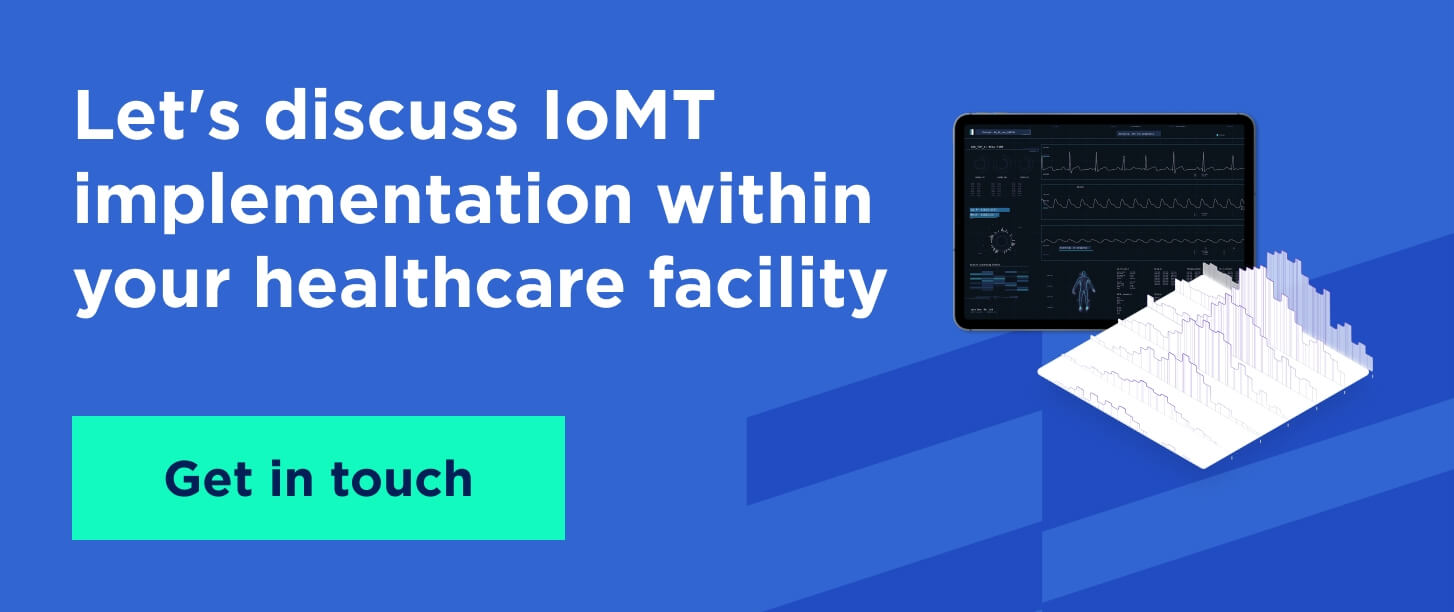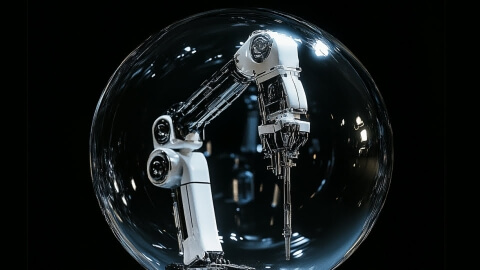The healthcare system is shifting to easy disease detection and diagnosis, prevention of disease spread, and patient self-education on their health and specific illnesses. Implementing the Internet of Medical Things will simplify medical digitalization by interconnecting devices and systems in a single network.
Our latest article examines the specifics and benefits of implementing the Internet of Medical Things for certain healthcare facilities, global healthcare systems, and medical services.
What is IoMT: explained
IoMT stands for the Internet of Medical Things (IoMT), which enables remote patient monitoring and treatment using smart medical wearables integrated with sensors and connected to a telehealth software system.
According to the Acumen statistics, the global connected medical devices market is projected to reach US$181.9 Billion by 2030, with a considerable CAGR of 22.1%.
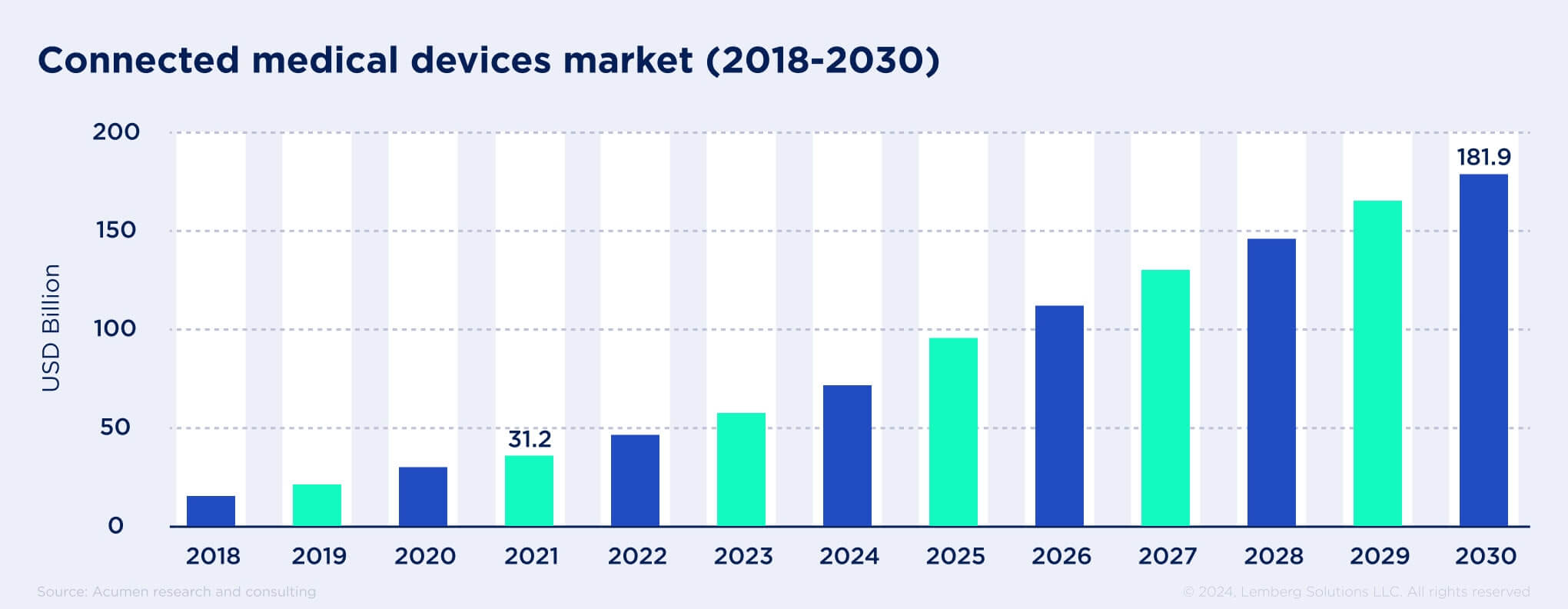
The Internet of Medical Things helps healthcare units create a centralized network of interconnected medical systems and devices that communicate with one another. It provides secure and real-time patient data exchange and storage collected from smart medical devices integrated with sensors, GPS, and other options to track patients' vitals and the course of diseases remotely.
Benefits of IoMT in healthcare
The Internet of Medical Things has already introduced many technical advancements into healthcare. It makes treatment more efficient, patient experiences more effortless, and the load for healthcare units lower.
Let's uncover more of the Internet of Things medical benefits, which enhance the quality of the healthcare system and make treatment available for everyone.
Cloud-based storage
The amount of patient information collected from smart medical devices is enormous. Along with being collected, it needs to be analyzed at a pace appropriate for the type of purpose it serves. For example, if we talk about healthcare wearables, caregivers and patients must receive immediate responses if health conditions change.
Additionally, all patient health information (PHI) should be stored in the database to keep the medical and treatment histories and make data-driven strategies and prescriptions for each patient.
Healthcare facilities should consider cloud-based computing, which provides a scalable and flexible database for storing all information from IoMT technology devices and systems, such as EHRs/EMRs, patient portals, mobile apps, etc.
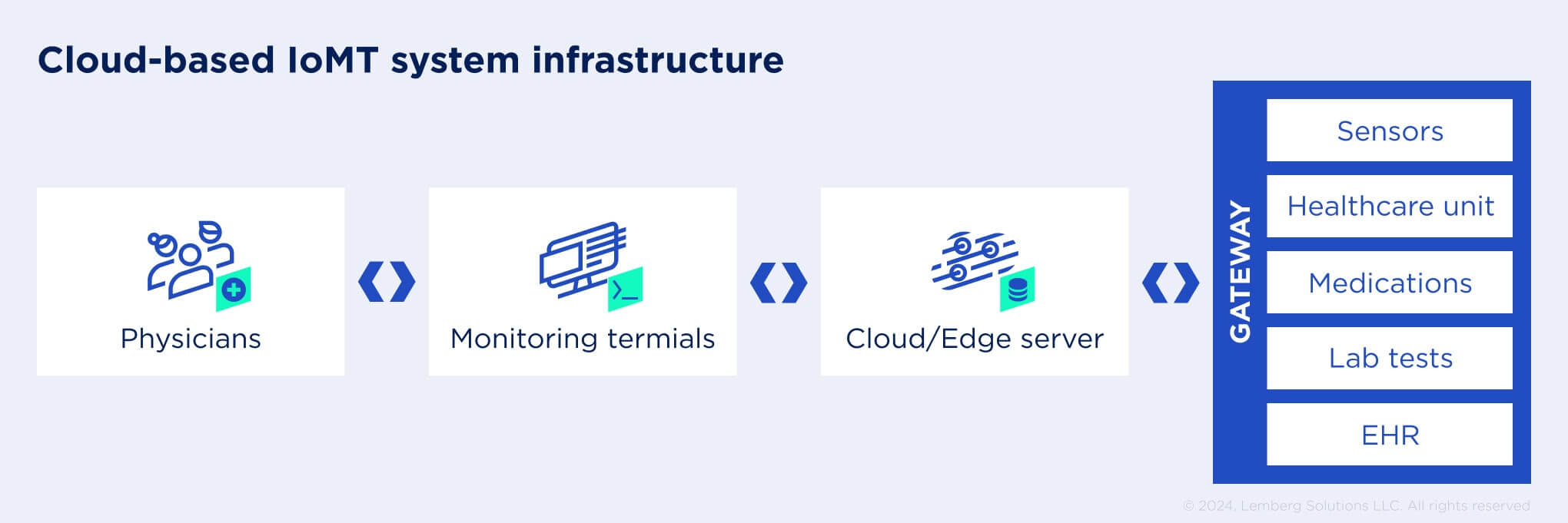
Uncover more details about cloud engineering and let our cloud experts help you outline the specifics of cloud-based solutions for your case.
Early medical intervention
Remote patient monitoring with IoMT devices allows caregivers and clinicians to observe health indicators around the clock and receive alerts about any changes. This feature is crucial for patients with chronic diseases who must be watched 24/7.
If sensors integrated into medical devices catch any unusual signs or behavior, physicians and patients get real-time signals to take immediate measures to prevent health deterioration.
Enhanced patient experience
Implementation of the Internet of Medical Things takes patient experience to another level. First, it eliminates the need for regular in-person doctor visits. You can monitor your health vitals, share your PHI with the healthcare unit, and get consultations from your physician without leaving your home.
Smart medical devices track all your health indicators and store this data on a server your physicians can access. You also get alerts if any condition has changed, especially critical ones. That leads to early doctor intervention and prevents disease complications.
Making healthcare available
The Internet of Medical Things makes healthcare available for people regardless of location and abilities, thanks to AI, machine learning, remote health monitoring, and virtual doctor visits.
This means you don't have to physically attend a healthcare facility to get a consultation, diagnosis, treatment plan, or constant health tracking. All these activities can be done remotely and according to your schedule, maintaining the same high-quality medical services.
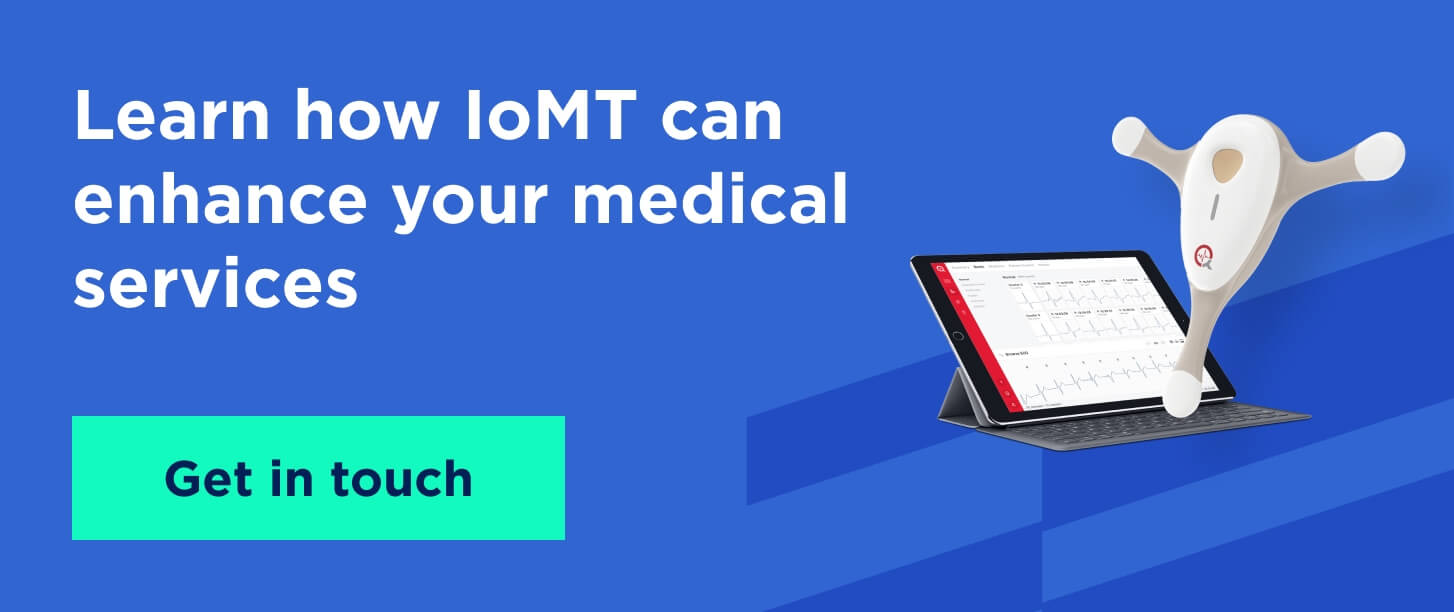
What are the challenges for IoMT?
Implementing the Internet of Medical Things and related healthcare software solutions and devices is challenging. Before diving into this process, we recommend you examine the potential difficulties to avoid or find solutions in advance.
Data security and privacy during exchange between devices and systems
Securely exchanging sensitive health information between medical devices and systems becomes challenge number one.
IoMT in healthcare enables the collecting, processing, and storing of vast amounts of data, and it should be available only to authorized parties within an IoMT network. That's why healthcare units should obtain data encryption methods for remote patients.
Processing of large amounts of data in real time
Patient health information management entails easy access, tracking, integration, and updates. Proper management might become challenging as IoMT devices collect vast volumes of data daily.
IoMT-based device validation
Every medical device must be validated to determine whether it adheres to required industry standards and compliance, depending on its purpose. This relates to integrated communication protocols, interfaces, data encryption, and other options.
IoMT devices should be developed according to HIPAA, GDPR, ISO13485, and other industry-related standards to be allowed for treatment and health monitoring purposes. Choosing an expert tech partner is crucial once you create an IoMT-based medical device or software system.
At Lemberg Solutions, we prioritize industry compliance and security regulations in our development life cycle as an ISO 13495, ISO 27001, and ISO 9001-certified engineering company.
5 types of demanded IoMT solutions in healthcare
The tremendous variety of IoMT devices and systems allows each healthcare unit to select the required solutions for its internal processes, medical services, and patient's needs.
Further, we covered the most popular IoMT solutions on the market that have found multiple use cases in the healthcare industry:

- Remote patient monitoring (RPM) – one of the most widely used medical devices to monitor patients` health vitals remotely, including blood pressure, body temperature, pulse, glucose, etc.; this is specifically helpful for patients with chronic diseases;
- Consumer wearables – fitness and activity tracking devices that enable patients to consider health self-management;
- Hospital management – this device type tracks hospital assets and manages internal processes, including inventory, patients, staff, and other resources.
- Smart pills – pills integrated with smart sensors triggered by stomach acid and immediately start transmitting vital health information to doctors.
- Smart hospitals – IoMT helps create a centralized network, connecting hospitals, patients, and smart medical devices to enhance health care and treatment.
Read also our case study outlining electronic nurse device MVP development for TCC.
Internet of Medical Things use cases
We collected the most popular use cases of the Internet of Things you might have heard about, outlining the benefits of IoMT for the healthcare industry.
Telemedicine platforms
A telemedicine platform is a software system that allows physicians to monitor and treat their patients remotely, ensuring severe real-time health data exchange, online consultations instead of in-person visits, tracking health vitals and getting alerted in emergencies.
Due to the Future Market Insights statistics, the global telehealth software market is set to experience a significant revenue increase by 2030, jumping from US$6.85 billion in 2023 to US$29.56 billion.
A telemedicine system commonly connects to patients` medical wearables, provides a patient portal, and stores electronic health records. However, such a solution can be integrated with any option required by a healthcare unit.
Our engineering team has experience developing an IoT telemedicine platform for remote patient monitoring that recognizes cough sounds, evaluates health conditions, and shares this information with clinicians. Follow this link to learn more details about the development process and its outcomes.
Virtual reality (VR)
VR has been used to treat mental health, anxiety, stroke, and pain and to manage and prevent obesity. Fundamental VR provides surgeons simulator-like training to practice surgical techniques in a controlled environment.
Artificial intelligence (AI)
AI software development services are used in healthcare to analyze clinical, lab, and demographic data for early detection, diagnosis, and prognostication of various conditions. AI can help identify, screen, monitor, resource, and predict potential interactions with suggested treatments.
Voice assistants
Voice assistants or chatbots have been widely used since COVID-19 hit the market. A digital assistant can connect with a specific clinician based on your symptoms, help you track medication intake, get directions for lab tests, etc.
Along with being helpful for remote patients, as one of the benefits of the internet in healthcare, voice assistants also reduce the workload from physicians who intervene in communication with patients as needed.
The process of IoMT implementation: key things to consider
Implementing IoMT is a gradual process that requires thorough investigation and preparation. It will transform the internal processes for patients, medical staff, and healthcare facilities.
There are a few critical things you should consider once you have decided the medical Internet of Things is what your healthcare units require the most at the moment:
- Know your goals in IoMT implementation – to define what types of devices and software systems your medical facility needs, you should outline expected changes and benefits, how IoMT solutions will be used across your facility and its processes, what functionality will benefit your medical services, and so on.
- Define the smart medical devices you need – as you know your core objectives, it is time to select specific types of IoMT devices and solutions like wearables with integrated sensors, a centralized hospital management platform, and a patient portal, depending on the goals and metrics you want to track.
- Partner with tech experts – indeed, you cannot be in charge of creating IoT infrastructure for your healthcare facility, designing and developing medical software or devices; that is why you should dedicate enough time and resources to find reliable and experienced tech experts with robust IoT and healthcare software development expertise to turn your IoMT network idea into reality.
- IoMT network support and maintenance – once the IoMT infrastructure is launched, it requires constant maintenance to ensure stable and secure operation and connection of medical devices and systems; healthcare solution also requires regular updates and functionality improvement/extension following industry standards and evolving needs of your healthcare unit.
The potential of the Internet of Things in medicine: transforming the industry
The healthcare industry is projected to keep shifting to complete digitalization and connection of all parties, including healthcare units, patients, caregivers, insurance companies, and test laboratories, to provide enhanced medical services.
It determines that the number of connected medical devices will keep evolving, enabling more healthcare facilities to integrate healthcare software systems and medical devices interconnected with IoT.
If you need professional consultation on what is IoMT and how to start implementing IoMT within your medical organization or support and upgrade an existing system, feel free to reach out to our IoT experts.
